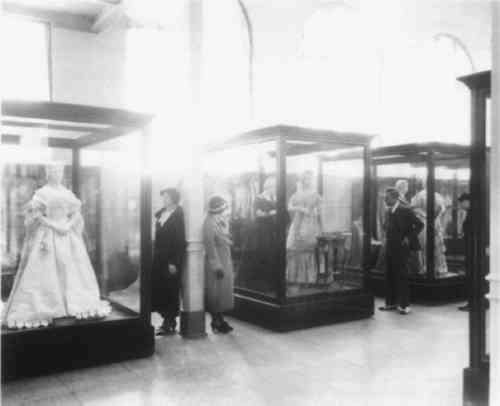THE U.S. FIRST LADIES GOWNS: A BIOCHEMICAL STUDY OF SILK PRESERVATIONMARY A. BECKER, POLLY WILLMAN, & NOREEN C. TUROSS
2 HISTORY OF THE FIRST LADIES COLLECTIONThe collection of costumes and accessories from the First Ladies of the United States of America is part of the Division of Political History at the Smithsonian Institution's National Museum of American History (NMAH), Washington, D.C. Fifteen silk gowns attributed to the First Ladies of the White House were displayed as part of a Period Costumes exhibit in the original U.S. National Museum building (now known as the Arts and Industries Building), opened to the public on February 1, 1914 (Smithsonian Institution 1914). The term “First Lady,” first used in 1860, is given to the “hostess” of the White House. Within just a few years, the exhibit was declared “one of the most interesting and popular in the Museum” (Smithsonian Institution 1919, 66). Of the original 15 silk gowns on display at the opening of the hall in 1914, 12 were still on display when the exhibition hall closed in 1987, and 11 had been shown continually during this 73-year period. The exhibit was initially located in the west-north range of the Arts and Industries Building (A&I), where the gowns were exposed to sunlight through large, west-facing windows, although these windows were intermittently protected by heavy curtains. In 1931 the exhibition was transferred to the north-west range of A&I where they could be illuminated with north light in order to make “artificial lighting of the collection unnecessary” (Smithsonian Institution 1931, 12) (see fig. 1). Daylight was not eliminated from the Collection of Dresses of the First Ladies of the White House exhibit until the construction of a series of period-room displays in the 1950s. Reduction of artificial light levels was initiated during the installation of the First Ladies Hall in the new Museum of History and Technology building (now NMAH) in 1964. Currently light levels in areas displaying the First Ladies costumes are 3 footcandles or less.
Over the years the gowns in the First Ladies Collection have been subjected to various forms of museum and user handling as well as different types of light. The collection is accompanied by irregular historical documentation on the garments, covers a broad time period from 1780 to 1989, and consists of fabrics in variable states of preservation. Of the 44 gowns on exhibit in 1987, 42 are constructed primarily of silk. The deleterious effects of light and dirt, as well as the demands of long exhibition, are so serious that some of the gowns are now too fragile to be exhibited. The silk fabrics in the gowns display a variety of museum-acquired degradative states. One example, Sarah Yorke Jackson's wedding dress, crumbling at the hem, was in such poor condition that now only the embroidered chiffon skirt is exhibited as part of a conservation section of the reopened exhibition. On the other hand, the silk in Barbara Bush's gown is in pristine condition. |
